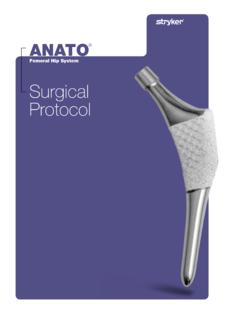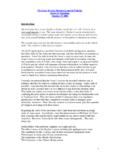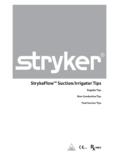Transcription of AxSOS 3® Titanium Locking Plate System - …
1 AxSOS 3 Titanium . Locking Plate System Humerus Fractures Operative Technique Proximal Lateral Humerus Universal Holes ORIF Instrumentation 1. This publication sets forth detailed recommended procedures for using stryker devices and instruments. It offers guidance that you should heed, but, as with any such technical guide, each surgeon must consider the particular needs of each patient and make appropriate adjustments when and as required. A workshop training is recommended prior to first surgery. All non-sterile devices must be cleaned and sterilized before use. Follow the instructions provided in our reprocessing guide (L24002000). Multi-component instruments must be disassembled for cleaning. Please refer to the corresponding assembly/disassembly instructions. Please remember that the compatibility of different product systems have not been tested unless specified otherwise in the product labeling.
2 See Instructions for Use (90-03200,90- 01953, V15011 and V15013) for a complete list of potential adverse effects, contraindications, warnings and precautions. The surgeon must discuss all relevant risks, including the finite lifetime of the device, with the patient, when necessary. 2. Contents Page Introduction 4. Product Details 5. Indications, Precautions & Contraindications 6 Operative Technique Pre-Operative Planning 7. Patient Preparation 8. Reduction 9. Initial Plate Fixation 9. Fixation of the Humeral Head 10. Final Fixation of the Shaft 12. Additional Fixation with Sutures 13. Final Fluoroscopic Check 14. Implant Removal 14. General Information Optional Aiming Block 15. Universal Holes 16. Additional Tips 17. 3. Introduction The AxSOS 3 Titanium Locking Plate System is intended for long bone fracture fixation.
3 The AxSOS 3 Titanium design concept draws upon the broad clinical expertise of an international panel of surgeons who developed, tested and validated the AxSOS . System . This hybrid fixation concept is designed to allow the surgeon to stabilize fractures by use of the lag screw technique through the Plate , or Locking screws to allow for adequate stability to comminuted, unstable fractures. This Operative Technique contains a step-by-step procedure for Open Reduction Internal Fixation (ORIF). implantation of the AxSOS 3. Proximal Lateral Humerus Plate . 4. Product Details Screw Types Cancellous Full Thread Screw Cancellous Partial Thread Screw Cortex Shaft Screw Cortex Screw Locking Screw Screwdriver interface T15 for all screws ( Locking and non- Locking ). Material Anodized type II Titanium alloy (Ti6Al4V).
4 Cancellous Locking Cortical -10 +10 . The universal holes allow the use of Locking and non- Locking screws except for the oblong and freedom/unthreaded holes, which accept non- Locking screws only. 5. Indications, Precautions &. Contraindications Indications Precautions Intended Use The AxSOS 3 Titanium Locking Plate stryker systems have not been evaluated The AxSOS 3 Titanium Locking Plate System is intended for long bone for safety and compatibility in MR System is intended for long bone fracture fixation. Indications include: environment and have not been tested fracture fixation. Diaphyseal, metaphyseal, epiphyseal, for heating or migration in the MR. extra- and intra-articular fractures environment, unless specified otherwise in the product labeling. Non-unions and malunions Normal and osteopenic bone Osteotomies Contraindications The physician's education, training and coverage over the operative site professional judgement must be relied Implant utilization that would upon to choose the most appropriate interfere with anatomical structures device and treatment.
5 Or physiological performance Conditions presenting an increased Any mental or neuromuscular risk of failure include: disorder which would create an Any active or suspected latent unacceptable risk of fixation failure infection or marked local or complications in postoperative care inflammation in or about the Other medical or surgical conditions affected area which would preclude the potential Compromised vascularity that would benefit of surgery inhibit adequate blood supply to the Detailed information is included in the fracture or the operative site instructions for use being attached to Bone stock compromised by disease, every implant. infection or prior implantation that See instruction for use for a complete cannot provide adequate support and/ list of potential adverse effects and or fixation of the devices contraindications.
6 The surgeon must Material sensitivity, documented discuss all relevant risks, including the or suspected finite lifetime of the device, with the Obesity. An overweight or obese patient, when necessary. patient can produce loads on the implant that can lead to failure of the fixation of the device or to failure of the device itself Patients having inadequate tissue 6. Operative Technique Pre-operative Planning Use of the X-Ray Template or E-Templates can assist in the selection of an appropriately sized implant. R EF 981200 Proximal Lateral Humerus Note: For conventional templates, the scale is 1 which usually matches with analogous X-Rays. If digital X-Ray images are used, correct magnification has to be verified prior to use. 7. Operative Technique Patient Preparation Patient Positioning - Beach Chair positioning on a radiolucent table allowing for free movement of the shoulder joint and the affected arm Surgical Approaches - Deltopectoral Approach The deltopectoral incision is the standard approach allowing for Plate fixation of proximal humerus fractures - Double Incision Approach*.
7 An alternative is to perform an additional incision for better visualization of the greater tuberosity and rotator cuff This approach offers without extensive incision length: - Direct deltopectoral view on the fracture site On the humeral head, if desired On the lesser tuberosity allowing for suture placement - Direct lateral view on the greater tuberosity and the Deltopectoral rotator cuff allowing for suture Approach placement, simultaneous rotator cuff repair and allowing for additional Neer's acromioplasty to avoid, if necessary, subacromial impingement of the Plate Insertion of the Plate and fixation of the humeral head screws via the lateral incision, control of the distal Plate positioning and insertion of the distal screws via the deltopectoral incision. Due to the large distance Double Incision Approach between the two incisions there is no increased risk for soft tissue The 2 incisions are carefully marked necrosis.
8 Before the procedure. A standard deltopectoral incision line is drawn first, Note: while a longitudinal lateral incision line When making the lateral is placed at the posterior border of the incision, care must be taken humeral head. The 2 incisions are parallel not to damage the axillary and separated by roughly 10cm. nerve. *. Gallo RA, Zeiders GJ, Altman GT. Two-incision technique for treatment of complex proximal humerus fractures. J Orthop Trauma. 2005 Nov- Dec;19(10):734-40. 8. Operative Technique Reduction In the first step, a gross reduction of the fragments should be achieved by indirect reduction maneuvers or direct fragment reduction using elevators, retractors, or K-Wires as joysticks. Note: Care has to be taken to avoid additional injury of the surrounding soft tissue structures that may affect the blood supply of the bone fragments.
9 Initial Plate Fixation When an almost correct reduction of the fragments is achieved and verified by fluoroscopy, the Plate is positioned to the bone laterally to the intertubercular sulcus, whereby the superior rim of the Plate should be placed approximately 10mm below the superior aspect of the greater tuberosity in order to minimize the risk of subacromial impingement. For preliminary fixation of the Plate , a non- Locking cortex screw is inserted in the oblong hole and a K-Wire is inserted in the most distal K-Wire hole in the Plate to align the Plate with the bone axis. 9. Operative Technique With the preliminary fixed Plate in position, fine reduction of the head fragment and the greater tuberosity is performed using the proximal portion of the anatomically pre-shaped Plate as support.
10 Correct fragment reduction and the Plate positioning have to be verified by fluoroscopy. If required, the Plate position can be slightly adapted by removal of the distal K-Wire and shifting of the Plate along the oblong hole. After final Plate positioning, the alignment of the Plate to the humeral shaft is secured by insertion of a second cortex screw distally to the oblong hole. Fixation of the Humeral Head The humeral head fragment and greater tuberosity are preliminarily fixed with at least three K-Wires (705002). or (390192) that are inserted either in the suture holes at the rim of the Plate or via a K-Wire Sleeve (705003) attached to a Drill Sleeve (705004 or 705075) in a proximal Plate hole. When correct positioning of the head fragment and the greater tuberosity is confirmed by fluoroscopy, Locking screws are successively inserted in the humeral head, whereby a minimum number of 5 Locking screws is desired.














